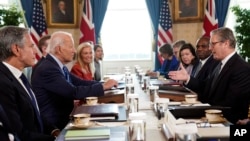WASHINGTON -- Ukrainian President Volodymyr Zelenskiy for months has been pleading with the United States and Britain for the right to use their long-range missiles to strike deep inside Russia.
He finally appears to be close to achieving his goal.
There has been noticeable momentum over the past few weeks to loosen those restrictions ahead of a key meeting between President Joe Biden and British Prime Minister Keir Starmer in Washington on September 13. The two leaders were expected to discuss support for Ukraine, among other topics, but not formally announce any change in policy.
But the meeting itself and other bits of information reported during the week gave the appearance that something was afoot. Asked on September 11 whether he would loosen the restrictions, Biden said, “We are working that out right now,” signaling a possible shift in his position. The comment came as many members of Congress, including those from his own Democratic Party, called on the president to ease his policy.
“I expect that we will see an announcement shortly about relaxing the restrictions. There has been tremendous buildup, and it would be very hard to backtrack,” Mark Cancian, a military analyst at the Center for Strategic and Institutional Studies, told RFE/RL.
“I suspect the United States and the U.K. are hammering out the conditions, in particular the target sets, because they will want to limit the strikes to military targets to avoid civilian casualties and suffering.”
The likely permissible targets for long-range strikes will include airfields, logistics hubs, depots, and headquarters, he said.
Ukraine has repeatedly struck Russian energy assets, in particular oil refineries and storage facilities, with their own homemade, long-range drones since the start of the year. Though they are legitimate military targets inside Russia, the Biden administration did not express support for the strikes.
The U.K.'s Guardian newspaper reported on September 12 that London has already given Ukraine the green light to use its Storm Shadow cruise missiles, which can travel up to 250 kilometers, for long-range strikes deep into Russian territory. The U.K. requires Washington's permission because the missiles contain U.S. parts.
Giving Ukraine the green light to use Army Tactical Missile Systems (ATACMS) -- a powerful, supersonic, ballistic missile that can travel as far as 300 kilometers -- to destroy Russian military assets far from the front lines following months of foot-dragging would be consistent with a pattern set by the Biden administration since the start of Moscow’s invasion.
The administration had initially denied Ukraine's requests for Abrams tanks, F-16 fighter jets, and long-range missiles like High-Mobility Artillery Rocket System (HIMARS) and ATACMS, in part amid concern it could provoke Russia. Biden eventually gave in to all those requests as pressure mounted from Ukraine, allies, and Ukraine supporters at home.
Earlier this year, as Russian forces concentrated near the border with the apparent intention to reinvade Kharkiv, Ukraine’s second-largest city, the Biden administration relaxed its policy and allowed Ukraine to fire ATACMS at forces just inside Russia, but no further.
Glide Bombs
The call to ease the restrictions on long-range strikes has grown this year as Russia continues to terrorize Ukrainian troops and cities with powerful glide bombs, which are difficult to spot on radar. Zelenskiy in June said Russia was dropping as many as 3,000 glide bombs a month.
The pounding of Ukrainian positions from the sky has enabled Russian ground troops -- albeit at extraordinary costs in human life and equipment -- to gain territory, threatening key logistics towns, like Pokrovsk.
The best defense against the glide bombs is to destroy the planes dropping them or push those planes farther from the front lines, something that can be achieved by targeting air bases, experts say.
But Cancian agreed with U.S. Defense Secretary Lloyd Austin's statement last week that easing the restrictions will not turn the tide of the war in Ukraine's favor.
The analyst pointed to the limited impact long-range Western weapons have had so far on Russia-controlled Crimea. Ukraine has struck Russian airfields and other military assets on the peninsula with those weapons. While this has weakened Moscow’s capabilities, it hasn’t been decisive in that theater of the war, he said.
He added that the use of long-range precision missiles inside Russia could make it more difficult for Moscow to launch glide bombs and force it to disperse headquarters and logistics hubs, making its military operation less efficient.
“It is not going to be a game-changer, but it would be helpful,” he said.
Putin's Threats
As momentum built this week to ease the restrictions, Russian President Vladimir Putin issued his latest warning to the West about supporting Ukraine, saying he would view such a policy change as the “direct participation” of NATO countries in the war in Ukraine. However, he did not say how he would react.
Putin in 2022 hinted at the use of tactical nuclear weapons, a comment that immediately provoked a negative response around the world, including from friendly countries like India. Earlier this year, following the latest U.S. policy change, he said Russia could supply lethal weapons to Western adversaries.
Putin’s saber-rattling has influenced the Biden administration’s cautious approach to supplying Ukraine with ever more sophisticated weapons such as F-16 fighter jets and long-range missiles and permitting strikes inside Russia. Some experts argue that Putin's threats are empty, saying he hasn't followed through on any to date, and that the United States should not heed them.
David Kramer, who served as U.S. assistant secretary of state for democracy, human rights, and labor from 2008-09, told a conference on September 12 that Putin is using the nuclear threat to undermine Western resolve.
“I really would caution against overstating the possibility of nuclear escalation. That is what Putin wants us to think. Let’s not fall for it,” said Kramer, a Russia expert who is now the executive director of the George W. Bush Institute.

